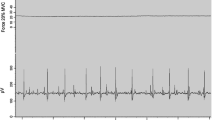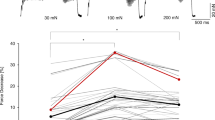Abstract
In most studies performed on motor units in mammalian muscles the division of these units into fast and slow types has been based on the ‘sag’ visible in the profile of unfused tetanus. The time course of the sag in unfused tetani of fast motor units was analysed in the present study. Fast units of rat medial gastrocnemius muscle were classified as fast fatigable (FF) or fast resistant to fatigue (FR) on the basis of a fatigue index calculated during the standard fatigue test. In middle-fused tetani (fusion index 0.25–0.75), it was observed that for FF motor units the sag was shorter and occurred earlier than for FR units. Moreover, in FF units, the sag was followed by potentiating tension, whereas for FR units this potentiation was weaker or even absent. A tetanus shape index, which expressed the ratio of the area of the first part of the tetanus record (between the tension record and the baseline, from the beginning of tetanus up to the lowest point during the sag in the tension record) to the area under the second part of tetanus (from this lowest point up to the end of the record) was introduced. For FF units, this index ranged from 0.13 to 0.47, whereas for FR units it ranged from 0.54 to 17.8 (with one exception). These results showed that the difference in unfused tetanus expressed in this tetanus shape index could be used as an accurate alternative method of dividing fast units into FF and FR groups. Moreover, the difference in sag time course in FF and FR groups. Moreover, the difference in sag time course in FF and FR units suggests that the metabolism responsible for this contractile phenomenon is significantly different time courses in IIa and IIb muscle fibres, constituting FF and FR units, respectively.
Similar content being viewed by others
References
Armstrong JB, Rose PK, Vanner S, Bakker GJ and Richmond FJR (1988) Compartmentalization of motor units in the cat neck muscle, biventer cervicis. J Neurophysiol 60: 30–45.
Bakels R and Kernell K (1995) Measures of ‘fastness’: force profiles of twitches and partly fused contractions in rat medial gastrocnemius and tibialis anterior muscle units. Pflügers Arch 431: 230–236.
Bennett MR and Ho S (1988) The formation of topographical maps in developing rat gastrocnemius muscle during synapse elimination. J Physiol 396: 471–496.
Burke RE (1981) Motor unit: anatomy, physiology and functional organization. In: Brooks VB (ed.) Handbook of Physiology. The Nervous System II. Part I (pp. 345–422). American Physiological Society, Bethesda, MD.
Burke RE, Levine DN, Tsairis P and Zajac FE (1973) Physiological types and histochemical profiles in motor units of the cat gastrocnemius. J Physiol 234: 723–748.
Burke RE, Rudomin P and Zajac FE (1976) The effect of activation history on tension production by individual muscle units. Brain Res 109: 515–529.
Celichowski J (1992) Motor units of medial gastrocnemius in the rat during the fatigue test. I. Time course of unfused tetanus. Acta Neurobiol Exp 52: 17–21.
Celichowski J and Grottel K (1992) The dependence of the twitch course of medial gastrocnemius muscle of the rat and its motor units on stretching of the muscle. Arch Ital Biol 130: 315–325.
Celichowski J and Grottel K (1995) The relationship between fusion index and stimulation frequency in tetani of motor units in rat medial gastrocnemius. Arch Ital Biol 133: 81–87.
Celichowski J, Grottel K and Bichler E (1998) The area under the record of contractile tension: estimation of work performed by a contracting motor unit. Acta Neurobiol Exp 58: 165–168.
Chamberlain S and Lewis DM (1989) Contractile characteristics and innervation ratio of rat soleus motor units. J Physiol 412: 1–21.
Dum RP, Burke RE, O'Donovan MJ, Toop J and Hodgson JA (1982) Motor-unit organization in flexor digitorum longus muscle of the cat. J Neurophysiol 47: 1108–1125.
Dum RP and Kennedy TT (1980) Physiological and histochemical characteristics of motor units in cat tibialis anterior and extensor digitorum longus muscles. J Neurophysiol 43: 1615–1630.
Enoka RE, Trayanova N, Laouris Y, Bevan L, Reinking, RM and Stuart DG (1992) Fatigue-related changes in motor unit action potentials of adult cats. Muscle Nerve 14: 138–150.
Filippi GM and Troiani D (1994) Relations among motor unit types, generated forces and muscle length in single motor units of anaesthetized cat peroneus longus muscle. Exp Brain Res 101: 406–414.
Fournier M and Sieck GC (1988) Mechanical properties of muscle units in the cat diaphragm. J Neurophysiol 59: 1055–1066.
Galler S, Schmitt TL and Pette D (1994) Stretch activation, unloaded shortening velocity, and myosin heavy chain isoforms of rat skeletal muscle fibers. J Physiol 478: 513–521.
Gardiner PF and Olha AE (1987) Contractile and electromyographic characteristics of rat plantaris motor unit types during fatigue in situ. J Physiol 385: 13–34.
Gauthier GF, Burke RE, Lowey S and Hobbs A (1983) Myosin isozymes in normal and cross-reinnervated cat skeletal muscle fibers. J Cell Biol 97: 756–771.
Goldman YE and Huxley AF (1994) Actin compliance: are you pulling my chain? Biophys J 67: 2131–2136.
Gordon DA, Enoka RM and Stuart DG (1990) Motor-unit force potentiation in adult cats during a standard fatigue test. J Physiol 421: 569–582.
Goslow GE, Cameron WE and Stuart DG (1977) The fast twitch motor units of cat ankle flexors. 1. Tripartite classification on basis of fatigability. Brain Res 134: 35–46.
Grottel K and Celichowski J (1990) Division of motor units in medial gastrocnemius muscle of the rat in the light of variability of their principal properties. Acta Neurobiol Exp 50: 571–588.
Hamm TM, Nemeth PM, Solanki L, Gordon DA, Reinking RM and Stuart DG (1988) Association between biochemical and physiological properties in single motor units. Muscle Nerve 11: 245–254.
Jami L, Murthy KSK, Petit J and Zytnicki D (1982) Distribution of physiological types of motor units in the cat peroneus tertius muscle. Exp Brain Res 48: 177–184.
Kadhiresan VA, Hasett CA and Faulkner JA (1996) Properties of single motor units in medial gastrocnemius muscles of adult and old rats. J Physiol 493: 543–552.
Kanda K and Hashizume K (1992) Factors causing difference in force output among motor units in the rat medial gastrocnemius muscle. J Physiol 448: 677–695.
Kernell D, Ducati A and Sjöholm H (1975) Properties of motor units in the first deep lumbrical muscle of the cat's foot. Brain Res 98: 37–55.
Kernell D, Eerbeek O and Verhey BA (1983a) Motor unit categorization on basis of contractile properties: an experimental analysis of the composition of the cat's m. peroneus longus. Exp Brain Res 50: 211–219.
Kernell D, Eerbeek O and Verhey BA (1983b) Relation between isometric force and stimulus rate in cat's hindlimb motor units of different twitch contraction time. Exp Brain Res 50: 220–227.
Kugelberg E and Lindegren B (1979) Transmission and contraction fatigue of rat motor units in relation to succinate dehydrogenase activity of motor unit fibres. J Physiol 288: 285–300.
Kwa SHS, Weijs WA and Jüch PJW (1995) Contraction characteristics and myosin heavy chain composition of rabbit masseter motor units. J Neurophysiol 73: 538–549.
Larsson L and Moss RL (1993) Maximum velocity of shortening in relation to myosin isoform composition in single fibres from human skeletal muscles. J Physiol 472: 595–614.
Lännergren J (1987) Contractile properties and myosin isoenzymes of various kinds of Xenopus twitch muscle fibres. J Muscle Res Cell Motil 8: 260–273.
Lev-Tov A, Pratt CA and Burke RE (1988) The motor-unit population of the cat tenuissimus muscle. J Neurophysiol 59: 1128–1142.
McDonagh JC, Binder MD, Reinking RM and Stuart DG (1980) Tetrapartite classification of motor units of cat tibialis posterior. J Neurophysiol 44: 696–712.
Macefield VG, Fuglevand AJ and Bigland-Ritchie B (1996) Contractile properties of single motor units in human toe extensors assessed by intraneural motor axon stimulation. J Neurophysiol 75: 2509–2519.
Nemeth PM, Solanki L, Gordon DA, Hamm TM, Reinking RM and Stuart DG (1988) Uniformity of metabolic enzymes within individual motor units. J Neurosci 6: 892–898.
Nowak A (1996) Fatiguability of fast motor units during intermittent stimulation at 60 Hz Biol Sport 13: 71–80.
Petit J, Filippi GM, Emonet-Dénand F, Hunt CC and Laporte Y (1990) Changes in muscle stiffness produced by motor units of different types in peroneus longus muscle of cat. J Neurophysiol 63: 190–197.
Reinking RM, Stephens JA and Stuart DG (1975) The motor units of cat medial gastrocnemius: problem of their categorization on the basis of mechanical properties. Exp Brain Res 23: 301–313.
Sieck GC, Fournier M, Prakash YS and Blanco CE (1996) Myosin phenotype and SDH enzyme variability among motor unit fibres. J Appl Physiol 80: 2179–2189.
Tansey KE and Botterman BR (1996) Activation of type-identified motor units during centrally evoked contractions in the cat medial gastrocnemius muscle. I. Motor unit recruitment. J Neurophysiol 75: 26–37.
Thomas CK, Johansson RS and Bigland-Ritchie B (1991) Attempts to physiologically classify human thenar motor units. J Neurophysiol 65: 1501–1508.
Unguez GA, Roy RR, Pierotti DJ, Bobine-Flower S and Edgerton VR (1995) Further evidence of incomplete neural control of muscle properties in cat tibialis anterior motor units. Am J Physiol 268 (Cell Physiol 37): C527–C534.
Author information
Authors and Affiliations
Rights and permissions
About this article
Cite this article
Celichowski, J., Grottel, K. & Bichler, E. Differences in the profile of unfused tetani of fast motor units with respect to their resistance to fatigue in the rat medial gastrocnemius muscle. J Muscle Res Cell Motil 20, 681–685 (1999). https://doi.org/10.1023/A:1005541013209
Issue Date:
DOI: https://doi.org/10.1023/A:1005541013209




